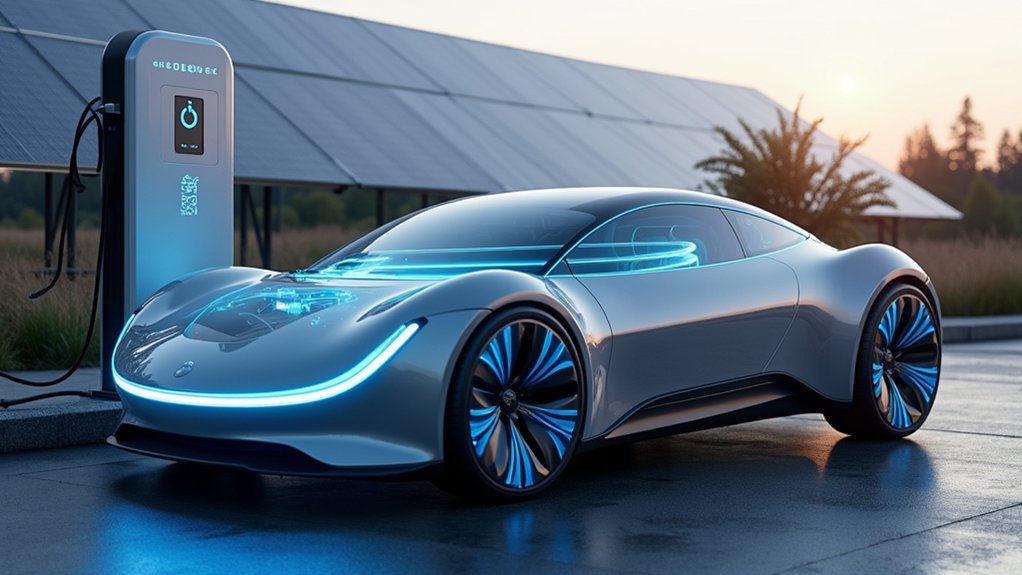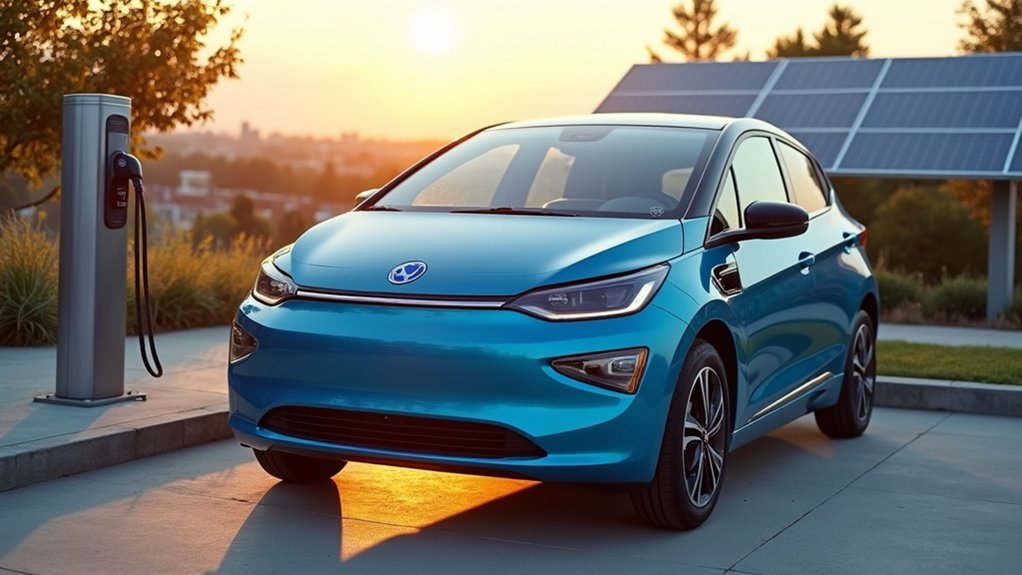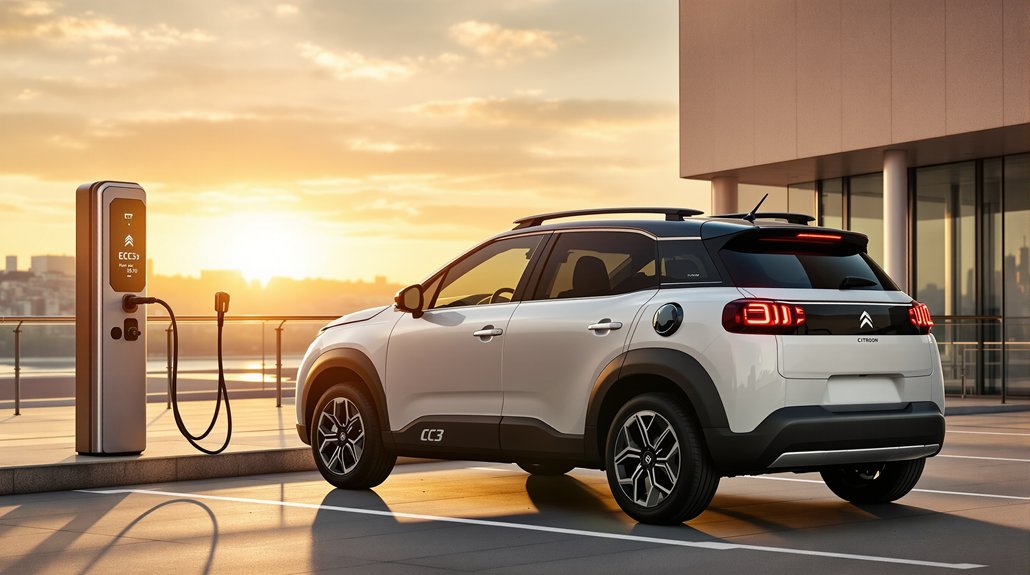Electric vehicle technology is experiencing rapid evolution across multiple fronts. Lithium-ion batteries now offer enhanced energy density, while ultra-fast charging capabilities deliver 80% charge in under 30 minutes. AI integration optimizes performance through advanced battery management and predictive maintenance. Wireless charging systems and bidirectional capabilities are reshaping infrastructure, while solid-state batteries promise even greater advances. The future of EVs extends far beyond traditional transportation solutions, with innovations continuously breaking new ground.

While traditional vehicles still dominate global roads, electric vehicle technology has undergone remarkable transformations in recent years, revolutionizing the automotive landscape. Lithium-ion battery chemistry improvements have greatly enhanced energy density, enabling EVs to achieve impressive ranges without compromising size or weight. Ultra-fast charging capabilities now allow vehicles to reach 80% charge in under 30 minutes, addressing one of the primary concerns among potential EV adopters. Range anxiety concerns have persisted since the earliest days of EVs, making charging infrastructure development critical for mass adoption. Global EV sales reached an impressive milestone with 6.6 million units sold in 2021, demonstrating growing consumer acceptance.
Electric vehicles are transforming modern transportation through advanced battery technology, delivering enhanced range and rapid charging capabilities.
The integration of AI technology has transformed how EVs operate and interact with their environment. Advanced battery management systems leverage artificial intelligence to optimize charging cycles, predict range accurately, and enhance overall vehicle performance. These systems work in conjunction with predictive maintenance algorithms to identify potential issues before they become critical, greatly reducing ownership costs and vehicle downtime.
Infrastructure development has kept pace with vehicle innovation, particularly in charging technology. Tesla’s Supercharger V4 network exemplifies this progress, while emerging wireless charging systems promise to eliminate the need for physical connections altogether. The implementation of bidirectional charging capabilities has turned EVs into mobile power stations, capable of supporting grid stability through Vehicle-to-Grid (V2G) technology or powering homes during outages. The development of robust recycling systems has become crucial for sustainable EV battery management as the industry continues to expand.
Energy efficiency improvements continue to extend the practical utility of EVs. Regenerative braking systems capture kinetic energy that would otherwise be lost, while aerodynamic designs and lightweight materials minimize energy consumption. The integration of solar charging stations with traditional charging infrastructure has begun reducing grid dependency, making EVs increasingly sustainable.
Perhaps most promising is the ongoing research into solid-state batteries, which could revolutionize EV capabilities with improved energy density, faster charging times, and enhanced safety profiles. Combined with smart energy systems that dynamically balance grid load and innovative battery swapping stations, these advancements are rapidly dismantling the remaining barriers to widespread EV adoption.
The convergence of these technologies suggests that EVs are not just the future of transportation – they’re increasingly becoming the present.
Frequently Asked Questions
How Long Do EV Batteries Typically Last Before Needing Replacement?
Modern EV batteries typically last 15-20 years or 200,000 to 280,000 miles before requiring replacement, with annual degradation rates averaging 1.8-2.3%.
While federal regulations mandate 8-year/100,000-mile warranties, many manufacturers offer extended coverage.
Environmental conditions, charging habits, and driving patterns greatly influence longevity, with some Tesla models demonstrating potential for 400,000+ miles of service life under ideal conditions.
Can Extreme Weather Conditions Significantly Impact an Electric Vehicle’s Performance?
Extreme weather greatly impacts EV performance, with cold temperatures causing the most dramatic effects.
At -4°F, vehicles can lose up to 50% of their range due to reduced battery efficiency and increased HVAC demands.
Hot weather above 95°F typically reduces range by 15-17% as cooling systems draw additional power.
Modern thermal management systems, including heat pumps and smart energy recovery, help mitigate these weather-related performance losses.
What Happens to EV Batteries After They’re No Longer Suitable for Cars?
EV batteries typically retain 70-80% capacity when retired from vehicles and find new life in second-use applications.
Most serve as stationary energy storage units, supporting power grids and renewable energy systems.
Those unsuitable for repurposing undergo recycling through hydrometallurgical processes, recovering 90-99% of valuable materials like nickel and cobalt.
Some facilities use direct recycling to salvage intact electrodes, though this technology remains experimental.
Are There Enough Raw Materials Globally to Meet Future EV Battery Demand?
Raw material availability presents significant challenges for future EV battery production.
While global reserves of lithium, nickel, and graphite are technically sufficient, current extraction and processing capabilities fall short of projected demand.
With lithium demand expected to increase 14-fold by 2040, supply chain bottlenecks and geographic concentration of resources, particularly in China, pose serious constraints.
Technological innovations and recycling initiatives will be essential to bridge the supply gap.
How Does the Carbon Footprint of EV Manufacturing Compare to Conventional Vehicles?
EV manufacturing generates approximately 80% higher carbon emissions compared to conventional vehicles, primarily due to battery production processes.
While both vehicle types have similar raw material footprints, EV assembly can be up to five times more carbon-intensive.
However, EVs offset these initial emissions within 19,500 miles of driving through superior operational efficiency.
Manufacturing emissions continue to decrease as automakers adopt renewable energy and cleaner production methods.







2 comments